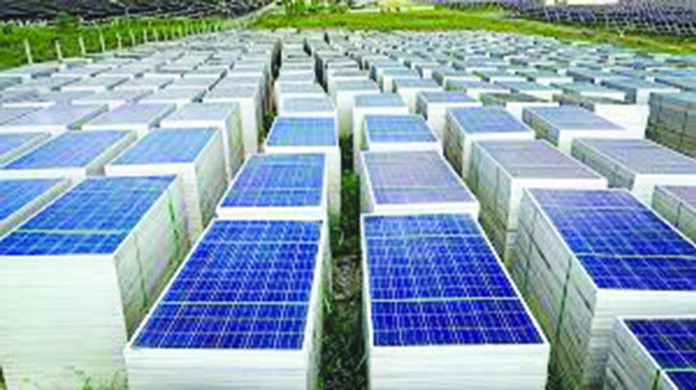The rapid growth of solar energy installations around the world has been a significant step towards reducing carbon emissions and combating climate change. However, as the lifespan of solar panels ranges from 25 to 30 years, there is a pressing need to address the issue of electronic waste, or e-waste, generated by the disposal of these panels. With billions of solar panels installed globally, experts warn of a potential environmental disaster if proper recycling and disposal systems are not put in place. Estimates indicate that by 2030, there could be four million tons of scrap solar panels, and by 2050, this number could exceed 200 million tons globally. To put this into perspective, the current global annual production of plastic stands at 400 million tons. Thus, the scale of the potential e-waste issue necessitates immediate attention and the development of comprehensive recycling chains.
Solar panels, also known as photovoltaic (PV) modules, are composed of several key components that work together to convert sunlight into usable electricity. The composition of solar panels typically includes photovoltaic cells, which are the heart of a solar panel and are responsible for converting sunlight into electrical energy.
The cells are usually made of silicon, which is a semiconductor material. Silicon can be either monocrystalline (made from a single crystal structure), polycrystalline (made from multiple crystals), or thin-film (made by depositing a thin layer of semiconductor material on a substrate). Monocrystalline and polycrystalline silicon cells are the most commonly used in solar panels.
These solar cells are encapsulated to protect them from moisture, dust, and mechanical damage. Ethylene vinyl acetate (EVA) is commonly used as the encapsulation material. It is a transparent and durable polymer that acts as a protective layer. Solar panels have a top layer made of tempered glass or a transparent back sheet. This layer provides structural support, protects the underlying components from environmental factors, and allows sunlight to pass through.
Behind the photovoltaic cells, there is a back sheet layer that acts as a barrier against moisture and protects the solar cells from the backside. The back sheet is typically made of a polymer material like polyester or fluoropolymer. The solar panels have a frame around the edges, usually made of aluminum. The frame provides structural support and helps protect the panel during installation and transportation.
The junction box is located on the back of the solar panel and houses electrical connections. It allows for the wiring of multiple panels in a solar array and facilitates the connection to an inverter or other electrical components. Solar panels have electrical wires that connect the junction box to the external electrical system. Connectors, such as MC4 or Amphenol connectors, are often used to join multiple panels together or connect them to other system components.
Improper disposal of solar panels can lead to significant environmental hazards. One of the main concerns is the presence of heavy metals such as lead, cadmium, and selenium within the panels. When solar panels are not properly managed, these metals can leach into the soil and water, posing risks to ecosystems and human health. Heavy metals are known for their toxicity and can bioaccumulate in the food chain, causing long-term damage to organisms. In addition to heavy metals, solar panels may contain hazardous substances like poly brominated diphenyl ethers (PBDEs) used in flame retardants and polychlorinated biphenyls (PCBs) found in older models. When solar panels are disposed of improperly, these substances can be released into the environment, leading to soil and water pollution.
Exposure to hazardous substances can have adverse effects on both wildlife and human populations. Furthermore, the improper disposal of solar panels consumes valuable landfill space. As landfills become increasingly scarce, the accumulation of solar panels exacerbates this problem. Additionally, the disposal of solar panels in landfills represents a missed opportunity for resource recovery since many of the materials within the panels can be recycled or reused. Another concern is the release of greenhouse gases. When solar panels are incinerated or left to decompose in landfills, they contribute to the emission of greenhouse gases such as carbon dioxide and methane. These emissions contribute to climate change and global warming, further exacerbating environmental issues.
By embracing these endeavors, we can create a brighter future where renewable energy technologies are not only clean and efficient during their lifespan but also responsibly managed at their end, leaving a lasting positive impact on our planet.
Proper disposal and recycling practices for solar panels are crucial to address the environmental hazards associated with their end-of-life management. Recycling processes involve collecting solar panels, preprocessing to remove external attachments, depaneling to separate photovoltaic cells, shredding or delamination to isolate materials, and recovering valuable components like silicon, silver, copper, aluminum, and glass. Refining and purification ensure the recycled materials meet standards for reuse in new panels or other applications. Incorporating recycled materials reduces reliance on virgin resources and mitigates the environmental impact of manufacturing.
To effectively manage the waste generated by solar panels, it is crucial to establish comprehensive environmental management plans. These plans should encompass various key components to ensure sustainable waste management practices. Firstly, it is the need of hour to raise awareness and provide education to consumers, installers, and manufacturers. By emphasizing the importance of proper waste management for solar panels, stakeholders can better understand the potential environmental impacts and become aware of available recycling options.
Designing solar panels with recyclability in mind is another crucial aspect. Encouraging manufacturers to use easily separable and recyclable materials, while minimizing the use of hazardous substances, can significantly facilitate the recycling process. Implementing standardized labeling for identification during recycling can further streamline the management of end-of-life panels. Establishing collection systems and take-back programmes is imperative to ensure the proper disposal and recycling of used solar panels.
Collaboration among manufacturers, installers, and recycling facilities can help set up collection points and facilitate the return of panels that have reached the end of their life cycle. Developing dedicated recycling infrastructure and facilities specifically designed for solar panels is vital. Investing in research and development can drive improvements in recycling technologies, enhance efficiency, and reduce associated costs. This can be achieved through the exploration of innovative recycling methods and the identification of opportunities for resource recovery from waste panels.
Implementing a regulatory framework is essential to enforce responsible management of solar panel waste. This can involve the implementation of regulations and policies that establish mandatory recycling targets, extended producer responsibility (EPR) programs, and product stewardship regulations. Holding manufacturers accountable for the end-of-life management of their products can incentivize sustainable practices.
In the pursuit of a sustainable future, conducting comprehensive life-cycle assessments of solar panels becomes an invaluable tool. By understanding the environmental impacts throughout their production, use, and end-of-life stages, we gain valuable insights that can shape decision-making, drive improvements, and prioritize environmentally friendly practices.
However, addressing the global challenges of solar panel waste management requires a united front. Collaboration, information sharing, and international cooperation among governments, industry stakeholders, and research institutions are crucial to developing best practices and sharing knowledge on recycling technologies and strategies. Furthermore, investing in research and innovation opens doors to new possibilities. Exploring alternative materials, advancing recycling methods, and discovering ways to recover resources from waste panels pave the way for a more sustainable and efficient approach to solar panel recycling.
By embracing these endeavors, we can create a brighter future where renewable energy technologies are not only clean and efficient during their lifespan but also responsibly managed at their end, leaving a lasting positive impact on our planet.






















